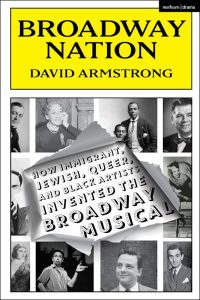David Armstrong’s new book, “Broadway Nation,” shines the spotlight on cultural contributions from marginalized groups
A UW course becomes a book about Broadway's roots in immigrant, Jewish, Black and Queer communities.
When David Armstrong was invited to teach a UW course on the history of the Broadway musical, he knew he wanted to take a different approach. What emerged was more than a popular class—it became a podcast, and now, a new book: “Broadway Nation: How Immigrant, Jewish, Queer, and Black Artists Invented the Broadway Musical.”

David Armstrong worked in professional theater for 40 years as a director, writer, producer and choreographer. Photo by Mark Kitaoka.
Armstrong, an affiliate instructor in the School of Drama and former executive producer and artistic director of Seattle’s 5th Avenue Theatre, traces the art form’s evolution and provides a cultural and historical study of how the Broadway musical was predominantly created by people marginalized from mainstream society.
“The artists who created the Broadway musical, and who have sustained it over its 125-year history, have overwhelmingly come from marginalized groups,” Armstrong says. “That includes some we may not think of as marginalized today. … For example, Irish immigrants are so much a part of this story, and they were at the bottom of the social scale at the turn of the 20th century.”
Armstrong grew up fascinated with both musicals and history. “Even as a kid, I used to say: Everything I know about history I learned from Broadway musicals,” he says.
That connection between the stage and the larger world became a cornerstone of his work. He points out that Broadway musicals both reflect and shape American culture. Unlike older, aristocratic art forms, musicals come from the streets. Artists like George M. Cohan aimed to bring real life to the stage. “The Broadway musical is a democratic art form,” Armstrong says. “It captures the essence of American life.”

David Armstrong’s UW course on Broadway musical history inspired a podcast called “Broadway Nation.” Now, he has written a book about Broadway’s roots in marginalized communities.
Even when musicals are dismissed as fluffy or unrealistic, Armstrong says they’re often delivering powerful messages—just in entertaining ways. “The great musicals are about something important at the heart of American culture,” he says. “Audiences may not be aware of it, but those themes are being absorbed.”
According to Armstrong, the most ubiquitous theme across Broadway history is transgressive women—female characters who challenge societal expectations. “Musicals [like ‘Wicked’ or ‘Gypsy ’] have most often centered on women, usually unmarried and working women,” who are not doing what society tells them to do, he says. Women are typically represented as subservient in other American media.
The second major theme is equity and inclusion. Shows from “Show Boat” to “Rent” to “Hamilton” have directly addressed race, class and justice. Armstrong includes a chart in his book listing 35 hit musicals that center around these themes.
Finally, community is a core concern. Musicals like “Oklahoma!” and “Come From Away” model thriving communities, while “West Side Story” and “Sweeney Todd” focus on communities that are broken down and in trouble.
“The secret sauce of the great musicals is that they are almost always about important issues that are at the heart of American culture. But people aren’t always aware of that because they’re presented in such a wildly entertaining fashion,” Armstrong says. “Still, I believe the underlying subject matter is being absorbed by audiences subliminally. That’s what makes musicals so transgressive—they have this underlying message and hidden power.”